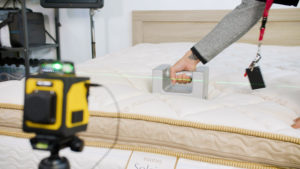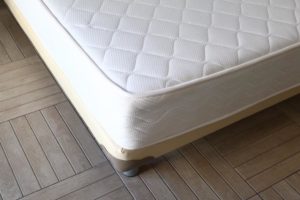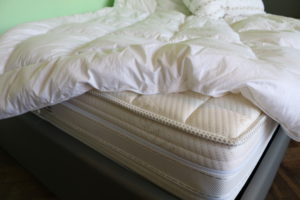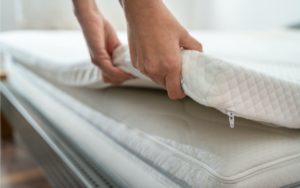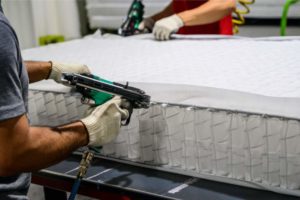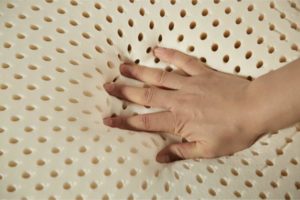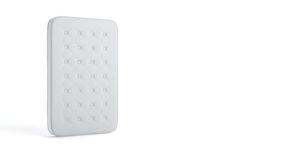When you buy through our links, we may earn a commission. Products or services may be offered by an affiliated entity. Learn more.
Fiberglass in Mattresses: What Does It Do and Is It Safe?
The word “fiberglass” may bring boats and insulation to mind, but this versatile, synthetic fiber often acts as an affordable, chemical-free fire retardant in mattresses. Flame retardants are chemicals or other materials intended to slow the spread of a fire and make a mattress less flammable. Manufacturers of budget-friendly mattresses typically use fiberglass in an effort to keep prices down and meet federal regulations. That said, its safety is somewhat controversial due to the potential health risks from exposure to damaged or uncovered mattresses.
We explore what fiberglass is, how it’s used in mattresses, and potential complications of coming in contact with fiberglass. You’ll better understand the level of risk involved with a mattress containing fiberglass as well as how to safeguard yourself. If you decide fiberglass isn’t for you, we share alternative materials that have proven to be effective fire retardants.
Let us help you find the perfect bed
Answer a few questions to find the right mattress for your unique needs
What Is Fiberglass?
As its name suggests, fiberglass is made of glass fibers that are formed by extruding molten glass through tiny holes. This creates fine, wispy fibers that can be used as insulation or combined with other materials for strong, lightweight reinforcement that is impervious to heat. By modifying the extrusion process, manufacturers can change the fibers’ composition to suit different purposes.
Fiberglass has many applications across several industries, such as insulation, pipes, electronics, cars, and boats. Besides being inexpensive to produce, it is nonflammable, resistant to corrosion, durable, and easily molded. Because of these qualities, fiberglass has become a popular material used in over 40,000 applications. Fiberglass may also be called glass fiber, glass wool, and man-made vitreous fibers (MMVF).
How Fiberglass Is Used in Mattresses
Fiberglass is often used as a flame retardant in mattresses to meet federal safety standards. Fiberglass protects against a fire’s spread, because fire slowly melts the glass fragments, which create a barrier between the flames and more combustible materials.
Instead of standing alone as a separate layer, fiberglass is typically woven into the mattress material directly beneath the inner mattress cover surrounding the mattress interior. Memory foam mattresses are most likely to contain fiberglass. A mattress that contains fiberglass may not list it on the label.
Other benefits of fiberglass include:
- Lightweight: Lightweight fibers aren’t as heavy as some other fire retardant materials.
- Affordable: Fiberglass is inexpensive to manufacture and can help keep a mattress’ price down.
- Chemical-free: Fiberglass doesn’t cause the adverse health effects that can occur with chemical fire retardants unless it leaks out of the mattress.
Is Fiberglass in Mattresses Safe?
Fiberglass in a mattress is safe as long as it doesn’t escape from the mattress, allowing a person to touch or inhale it. If the mattress and cover are intact, the fiberglass inside should not be able to escape or cause harm. However, in some cases, unzipping a zip-up mattress cover could potentially cause fiberglass exposure.
Fiberglass in a mattress is intended to increase the safety of the mattress by reducing flammability. To ensure its effectiveness, mattresses must meet federal fire safety regulations by undergoing testing. This involves placing lit cigarettes on the mattress’ surfaces and measuring the char length, which must not exceed 2 inches from the cigarette.
Potential Health Risks
Risks from fiberglass exposure may occur if your mattress is torn or uncovered. This releases the tiny glass fibers into the air, which can result in a number of health effects:
- Skin rash: Fibers become lodged in the skin and cause irritation.
- Red eyes: Floating fiberglass irritates the surface of the eyes.
- Breathing problems: When inhaled, the glass fibers may aggravate asthma and bronchitis and cause a sore throat, chest infection, or pulmonary fibrosis.
- Stomach ache: If swallowed, fiberglass can irritate the stomach.
The microscopic size of fiberglass allows it to travel through the air into every part of your home. It settles on furniture, carpets, and can find its way into air ducts, furnaces, and air conditioners. You may not easily see it or realize it is touching you or being inhaled until you experience symptoms.
To avoid this hazard, leave the mattress cover intact and follow the manufacturer’s instructions. As long as the fiberglass is completely enclosed, you should be reasonably safe from harmful health effects. For further protection, you can also invest in a mattress protector or a mattress encasement.
How to Identify Fiberglass in Mattresses
Upon close inspection, fiberglass fibers may look like translucent, plastic threads. They typically have a shiny surface with a white or off-white color. If you think you see fiberglass on the outer surface of your mattress, do not touch it to avoid skin irritation and other harmful physical effects.
There are several ways to determine if a mattress contains fiberglass.
Label
The manufacturer’s label is the easiest way to tell if a mattress is made with fiberglass, though in some cases, it may not be listed. Also, many labels don’t specifically say “fiberglass.” Instead, they often use alternative terms such as “glass wool” or “glass fibers.”
Company
Online, most manufacturers list the materials used in their mattresses, especially the fire retardants. If this information is unclear, you can usually contact the company directly by calling, emailing, or using an online chat form to find out if a particular mattress contains fiberglass. The customer service department should be able to answer your questions.
Price
An affordable price tag, such as $600 or less for a queen size bed, is a good indicator the mattress likely contains fiberglass. Because it’s an inexpensive fire retardant, fiberglass is often used in budget-friendly mattresses to avoid an expensive price-point. However, some pricier models may also contain fiberglass.
Origin
Where a mattress is manufactured can affect the odds of it containing fiberglass. Mattresses made outside of the U.S. aren’t subject to the same standards and regulations. They may be more likely to contain fiberglass than mattresses that are made in the U.S.
How to Deal With Fiberglass That’s Leaked From a Mattress
Removing fiberglass that’s inside a mattress isn’t possible, because it’s usually woven throughout other materials. But if fiberglass leaks from a mattress, you want to have the leaked fiberglass removed from your home to avoid contacting it or inhaling it. Because fiberglass is a hazardous material, the safest way to remove leaked fiberglass from your mattress is to use a professional cleaning service.
While you may be tempted to clean leaked fiberglass yourself, know that you could risk exposure doing so. Wearing protective clothing like gloves, goggles, and a mask may reduce that risk, but isn’t as safe as hiring professionals. Other items that have come in contact with the fiberglass, like clothing or bedding, may need to be thrown away.
Alternatives to Fiberglass in a Mattress
Any mattress can contain fiberglass, but there are some types that don’t typically use it, like latex and organic mattresses. They offer shoppers more sustainable and environmentally friendly fire retardants that achieve the same results as fiberglass. That said, it’s advisable to always check with a mattress’ manufacturer to confirm its materials. We describe each fiberglass alternative material in detail to give you an overview.
Natural Wool
Wool is a popular naturally fire retardant material. Its high keratin and moisture levels make it difficult to ignite, and when lit, the flame typically extinguishes itself. Special compounds, treatments, and heat-resistant fibers are sometimes added to wool to improve its non-inflammatory properties.
Kevlar
Kevlar is a synthetic material known for its lightweight strength and thermal stability. As such, it has a wide range of applications, one of which is as a flame retardant in mattresses. Unlike many plastics, kevlar doesn’t melt and resists heat up to 850 degrees Fahrenheit. When ignited, it typically stops burning once the fire’s source is extinguished.
Rayon
Rayon is a semi-synthetic fiber that performs well as a fire retardant at a much lower cost than wool. It consists of cellulose, often sourced from wood pulp, that has been chemically processed. When this type of rayon is exposed to flames, the fibers soften and curl up in a ball, which slows the fire’s spread.
Silica
A common mineral in the earth, silica has been proven to minimize fire damage. When incorporated into fabric, it reduces the material’s overall flammability. Silica tends to form a compact char layer that restricts heat and smoke and suppresses the fire.
Carbon
Inorganic carbon is a heat-resistant material that doesn’t burn like organic substances, nor does it decompose and release toxic smoke. It can reduce the flammability of polyurethane foam by up to 35%. Adding carbon nanofibers to the foam provides a thermally stable network that contains melting foam and prevents it from dripping and spreading the fire further.

Still have questions? Ask our community!
Join our Sleep Care Community — a trusted hub of sleep health professionals, product specialists, and people just like you. Whether you need expert sleep advice for your insomnia or you’re searching for the perfect mattress, we’ve got you covered. Get personalized guidance from the experts who know sleep best.






